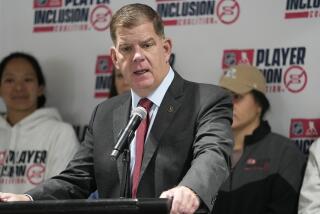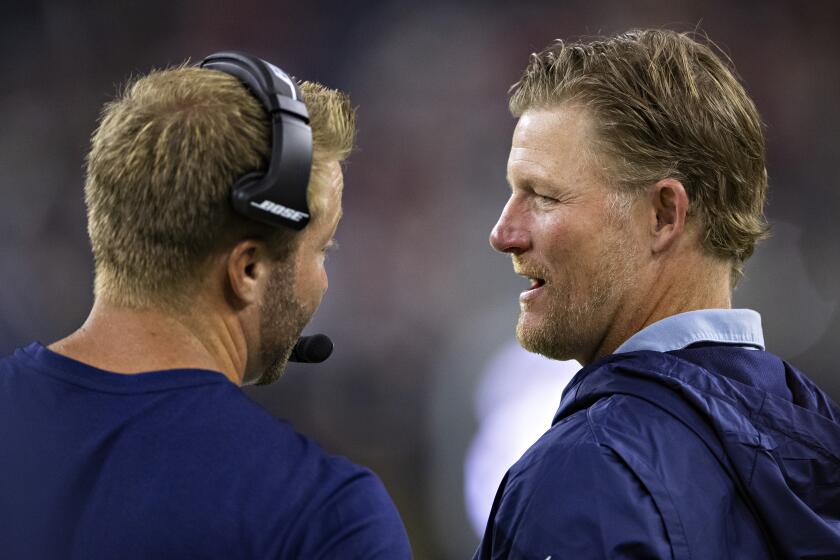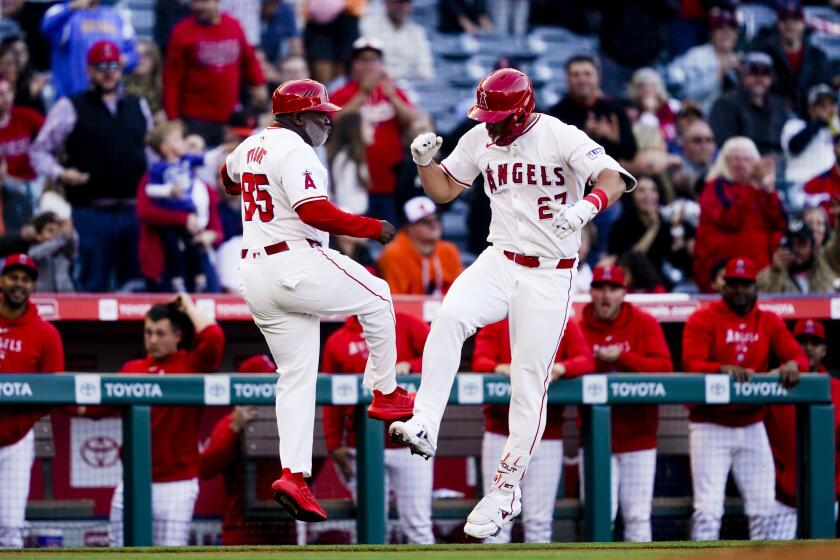NHL good at getting labor negotiations wrong
“I know the league’s future is bright, and this will be to the benefit of the game. We had no choice but to get it right.” — NHL Commissioner Gary Bettman, July 22, 2005, announcing the labor deal that ended a season-long lockout.
Whoops…. Maybe Bettman and the owners who authorized him to cancel the 2004-05 season didn’t get it right after all.
The collective bargaining agreement they negotiated with the NHL Players’ Assn. expires Sept. 15, and the league is again pushing hard for substantial givebacks by players. No new deal, no new season, Bettman has decreed, leaving the hockey world to face the third league-imposed lockout since 1994.
It figures: The Kings waited 44 years to win the Stanley Cup and the NHL will implode before they can raise their banner.
This dispute was predictable the moment the NBA and NFL won concessions that dropped players’ salaries to 47% of agreed-upon revenues in the case of the NFL and to 50% in the case of the NBA. The NHL, which navigated the recession surprisingly well and generated $3.3 billion in revenues last season, wants to change an equation that favored players by 57%-43% and make it 54%-46% in the owners’ favor.
The cut actually goes deeper because the NHL, citing higher business costs, wants to exclude some currently accepted hockey-related revenues from what players would share in the next deal. If business is booming why shouldn’t players share the bounty? The 57% share they want in the fourth year of their proposal is probably a bit high, but the NHL’s offer of 46% of a smaller pie is too low.
“We need to be paying out less in player costs.” — Bettman, Aug. 9, 2012.
Maybe so. But who told the New Jersey Devils to overbid for winger Ilya Kovalchuk, offering a 17-year deal that was reworked to $100 million over 15 years? How could the small-market Minnesota Wild afford to sign free agents Ryan Suter and Zach Parise to identical 13-year, $98-million deals in June?
The ink on that “get it right” labor deal hadn’t dried before general managers found ways to shred it, principally with front-loaded, long-term contracts that reduced the average annual value and salary-cap hit. Another escalating factor has been the huge jump players are taking from their entry-level deals to their second contracts. That rising tide brought other boats up with it.
The seven Canadian teams, helped by their dollar’s increased strength and the NHL’s return to Winnipeg, continue to account for about one-third of ticket revenues in a still heavily gate-driven league. The Toronto Maple Leafs and Montreal Canadiens will always be pillars of strength, but one small downturn in the value of the Canadian dollar could create havoc.
While Bettman is fond of pointing out that the NHL has increased its revenues from $2.2 billion before the current labor agreement to $3.3 billion, he’s less fond of discussing the franchise values of some unprofitable small-market teams.
In a story dated November, 30 2011, Forbes reported that Bettman had said three years earlier that no NHL franchise was worth less than $200 million. However, since then the Buffalo Sabres were sold for $165 million (plus debts), the St. Louis Blues sold for about $130 million and the Phoenix Coyotes’ sale has become a sad, strung-out saga. Former San Jose Sharks executive Greg Jamison has had trouble assembling the financing to meet the $170-million price tag the NHL set for the Coyotes, whom it has operated for nearly three years. Large-market teams are strong, but smaller markets struggle to operate profitably while meeting the rising salary floor, and they’ve gotten little help through revenue sharing.
That made it comical when Bettman last Friday dismissed the NHLPA’s insistence on discussing revenue sharing as “distracting.” In truth, he’s trying to placate powerful big-market owners who don’t want to share much with their small-market brothers. It’s clear several markets added through the NHL’s over-reaching expansion — and others that have been mismanaged — are causing problems owners won’t solve on their own, making lockout threats a certainty each time a labor deal expires.
“I hope it never happens again. We’re both going to kill each other if we do it again.” — Mike Gartner, then the NHLPA’s director of business relations, on losing a season to a lockout, July 21, 2005.
Sorry, but it looks like deja vu all over again. “We recovered last time because we have the world’s greatest fans,” Bettman said Aug. 23, and with reason. He has two advantages: Hockey remains best seen in rinks rather than on TV, and he knows fans’ bottomless passion will bring them back.
Whatever happens over the next two weeks fans will return, sadder but wiser. For the moment, they’re just sad this is happening again without much apparent chance of a long-term solution.
helene.elliott@latimes.com twitter.com/helenenothelen
More to Read
Get our high school sports newsletter
Prep Rally is devoted to the SoCal high school sports experience, bringing you scores, stories and a behind-the-scenes look at what makes prep sports so popular.
You may occasionally receive promotional content from the Los Angeles Times.







